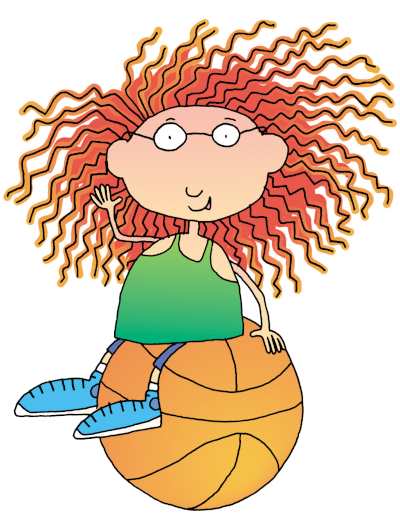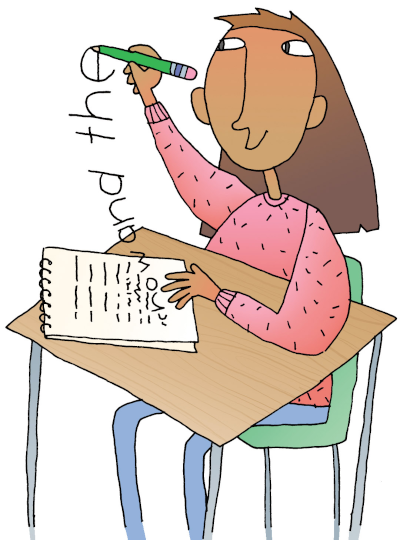Page 145

Writing Realistic Stories
Evelyn is a spunky 5 year old who is always on the go. She loves basketball and baseball and running . . . running everywhere! When her family moves to a new lake house, she runs down to jump in a canoe, and—as usual—chaos ensues.
Realistic stories are part real and part made-up. They usually have characters like Evelyn who remind you of people you know. These characters have realistic problems to solve. For example, Evelyn gets her family to chase her to a boat and climb in after her. You’ll have to find out what happens next by reading the realistic story in this chapter.
Then you will write a realistic story of your own!
What’s Ahead
WE 146
Page 146
Writing Realistic Stories
Before you can write your story, you need characters who seem real, who face believable problems to solve.
Prewriting Planning Your Story
Create a Character 🟪 To brainstorm characters, write names in the left column and fill in other details in the other columns. (Use this character creation sheet.) You don’t have to use all the details in your story, but they will help you imagine how the characters would look and act.
|
Name |
Hair |
Age |
Wears |
Mood |
Likes |
Dislikes |
|
Mom |
long brown |
45 |
glasses |
hard-working |
her kids |
chaos |
|
Mia |
short brown |
10 |
jeans |
cautious |
her dog |
chores |
|
Evelyn |
kinky red |
5 |
tank tops |
crazy |
chaos |
being bored |
|
Maya |
golden fur |
4 |
collar |
friendly |
her family |
missing out |
Find a Real Problem 🟪 Your characters need a problem to solve. Think of problems that you and your friends know about—problems at school, with friends, with family, or in the neighborhood. List problems for each category. Then decide which problem you want your character to solve. (Use this realistic story collection sheet,)
School:
noisy lunchroom, not enough swings
Friends:
my best friend is in a different class from me
Family:
my little sister likes to cause chaos
Neighborhood:
a boat tipped over in the pond yesterday
Mia’s Problem:
Her family’s boat tips over.
WE 147
Page 147
Writing Developing the First Draft
You can begin a story in many different ways. You can start out with a conversation, have a character do something, or describe the setting. However you begin, make the start realistic and interesting.
Start Your Story 🟪 Here are five ways to begin a story.
Begin with action or dialogue:
“Evelyn, don’t go near the lake alone!” Mom called out.
Ask a question:
What do you get when you combine a rambunctious kid, a tired mom, a fidgety dog, and a reasonable 5th grader in a boat?
Describe the setting:
It was around noon in the middle of fall. Tall trees with yellow and orange leaves were towering over the lake, along with green pine trees.
Begin with background information:
One windy fall day, Mom, Mia, Evelyn, and their family dog, Maya, were moving into the lake house that they bought.
Begin with foreshadowing—a hint of what is to come:
Among many other things that Mia hauled from the SUV to the lake house was a box full of towels. Little did she know how soon they would need them.
Keep Your Story Going 🟪 Don’t let your character solve the problem too easily. Try two or more actions before coming up with a final solution.
Solution 1: Mia objects to watching Evelyn.
Solution 2: Mia gets in the canoe to keep Evelyn safe.
Solution 3: Mia helps rescue Evelyn and Maya.
End Your Story 🟪 Give your story a realistic ending. Tell how the problem is resolved and what happens afterward.
Note People often change as they deal with a problem, so you might show how your character changes by the end of the story.
WE 148
Page 148
Revising Improving Your Writing
Review Your Work 🟪 Review your first draft to be sure that the characters’ words and actions make sense. Also check the length of your story—is it too short or too long? If some parts seem boring, change them or take them out. If something seems to happen too quickly, slow the pace of your story by adding to it.
Add Life to Your Story 🟪 If your story needs a little spice, try adding a few details, some dialogue, or more action.
- Use specific details. What interesting sights, sounds, smells, tastes, or textures could you add?
- Use realistic dialogue. Dialogue shows how your characters feel. Where in the story could you have your characters talk to each other?
- Use believable action. There’s nothing like a little action or suspense to keep a story exciting. What could you have your characters do?

Editing and Proofreading
Correcting Errors
Read Your Story 🟪 After making changes in your story, have a friend read it back to you. Is it smooth and clear from start to finish?
Check for Errors 🟪 Finally, check for spelling, punctuation, and grammar errors. Make a neat final copy of your story and proofread it before sharing it with your classmates. If you have time, divide the story into parts, illustrate the pages, and bind them into a book.
Tip You can use the Editing and Proofreading Checklist to make sure you’ve checked for every possible error.
WE 149
Page 149
Sample Realistic Story
Here is Julia Raleigh’s final draft of “Boating Trip.” Note how she uses action, dialogue, and description to bring her story to life. (See other stories for inspiration.)
Boating Trip
Beginning
The writer sets the scene and introduces characters. One windy fall day, Mom, Mia, Evelyn, and their family dog, Maya, were moving into the lake house that they bought. Mia’s little sister, Evelyn, dropped her bags in the house and ran out on the path leading to the lake.
Middle
Dialogue and action move the story forward. “Mia, can you watch Evelyn until I go down to the lake to join you two?” Mom called out.
Mia huffed. “Do I need to?”
Her mom sighed, shook her head, and made a fleeing gesture. Mia opened the door slowly, hoping her mom might change her mind or go with her. Their family dog Maya brushed against Mom’s leg, nudging her to the door.
Her mom put all the bags down and sighed. “Guess we can put bags away later and go check out the lake instead.”
Mia opened the door wider and walked outside, feeling Maya slip past her. Her mom walked on the left, while Maya walked on the right. They strolled in silence, enjoying the sunshine and occasionally tripping over Maya, who was weaving between them, tail wagging excitedly at all the new smells and sights.
Sensory details make the scene vivid. It was around noon in the middle of fall. Tall trees with yellow and orange leaves were towering over the lake, along with green pine trees. The blue sky peeked through the clouds, and the wind rustled the leaves. The air felt warm and damp against Mia’s face. Birds chirped and flew above Mia in the sky. The leaves crunched underfoot as she walked toward the lake shore. The frogs in the brush would sometimes croak. The leaves that had gotten wet gave off an earthy mildew smell.
The canoe had been in a bunch of leaves along with flowers. Now it was pushed into the lake.
WE 150
Page 150
Maya ran to greet Evelyn, who was already in the boat waiting for them. Mia and her mom got into the canoe and helped Maya get in. The boat tipped back and forth, and Evelyn struggled to get a grip on it. They eventually settled in the canoe and pushed off with the paddles. They got a decent amount away from the shore when Maya suddenly started pacing, making the boat tip back and forth.
Water started sloshing onto the floor of the canoe, making Evelyn shout, “Maya, stop!”
A crisis occurs, creating suspense. The boat tipped dangerously to the left, and suddenly, they all fell directly into the water. Mom swam to the canoe, flipped it back up, and pulled herself back in. She grabbed Evelyn’s flailing hands and hauled her into the boat. Mia splashed around trying to find Maya when she suddenly saw her golden fur swimming back to the canoe.
Dialogue and action show how the characters deal with the crisis. “Hey, Mom, can you help me get back in the boat?”
Her mom grabbed her hands and hauled her in.
Mia pointed at Maya, who was about a foot away from the canoe. “Do you need help getting her into the boat?”
“I’ve got it, don’t worry.” Her mother grabbed Maya’s collar and hoisted her up into the canoe.
“Is Maya all right?” Evelyn asked.
“Don’t worry. She’ll be all right!” Her mom responded. She grabbed one of the paddles and gave the other one to Mia. Her mom and Mia immediately started paddling home to dry off.
Ending
The falling action leads to a resolution, showing how things end up. They paddled to the shore, and everyone hopped out of the boat. Maya shook her fur, spraying everyone with water with the biggest smile on her face. Evelyn laughed, and she sprinted up the path to the house, racing Maya. Mia and her mom walked up more slowly, and when they finally got to the top, they opened the door to a panting Evelyn and a very happy dog.
Her mom immediately grabbed towels and blankets from the bedroom, and she covered them both up. Mia thought how little sisters and dogs were trouble, but they were also fun. After their exciting day, the family ended up buried in blankets and watching a movie.